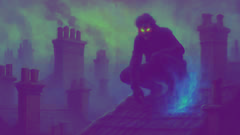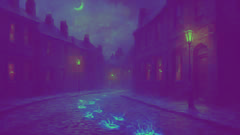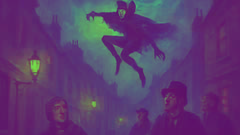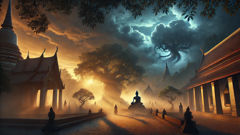Introduction
Fog crept along the cobblestone veins of Victorian London, rolling in thick from the Thames and swallowing the narrow alleyways that twisted through the city’s heart. Gas lamps struggled to pierce the gloom, their light pooling in trembling circles that flickered and danced with the movement of the mist. Each night, when the bells of St. Paul’s tolled and the working class hurried home, whispers drifted through taverns and tea shops alike—a name spoken with a shudder, a story told in nervous glances: Spring-heeled Jack. In the 1830s, the city was a cauldron of curiosity and fear. The Industrial Revolution had transformed London into a labyrinth of factories, soot-stained rooftops, and restless souls. The poor huddled in cramped tenements while the rich paraded along gas-lit promenades. Yet no one, regardless of their fortune, was safe from the blue-flame phantom who leapt across rooftops and vanished into the night. Sightings spread like wildfire: a figure, tall and gaunt, with eyes like burning coals and a cloak that seemed to ripple in the wind. Some said he wore a devil’s mask; others claimed his touch seared the skin, and his laughter chilled the blood. Most chilling of all, witnesses swore he could leap entire streets in a single bound—vanishing before the watchmen’s whistles could summon help. It wasn’t just his supernatural agility that haunted the city’s dreams. Spring-heeled Jack was said to breathe blue fire, a ghostly blaze that left the bravest constables frozen in terror. Parents clutched their children close, and gossip columns feasted on reports from Blackheath to Hammersmith. Was he a demon, a clever criminal, or a symptom of a city teetering on the edge of its own shadow? The legend of Spring-heeled Jack became a mirror, reflecting Victorian London’s deepest anxieties—about progress, the unknown, and the monsters that might lurk behind every swirling corner of the city.
The Shadow Among Chimneys
London in the late 1830s was a city of restless energy—a metropolis whose boundaries stretched daily as the modern age unfurled its wonders and horrors alike. By day, its streets thrummed with the thunder of carriage wheels, the cries of street vendors, and the ceaseless clang of industry. But when darkness descended, the city transformed. What was familiar in daylight became sinister under the cloak of fog and night. It was in this half-lit world that the legend of Spring-heeled Jack took root.

The first recorded encounter came in 1837, in the quiet suburb of Barnes. Mary Stevens, a maid returning from her parents’ home, hurried along Cut Throat Lane. The night was thick and silent—until a tall figure leapt from an alley, grasping her with icy fingers. Mary’s scream echoed down the street as the man’s eyes blazed red and blue flames burst from his mouth. He released her, vanishing with a leap so impossible that those who heard her tale the next morning dismissed it as hysteria.
But Mary was not the last. The very next night, a carriage near Blackheath swerved as a cloaked specter landed on its roof, causing the horses to bolt. The driver and passengers reported claws glinting in the moonlight and a mask twisted into a devil’s grin. The legend was born—not just in whispers but in headlines. Newspapers dubbed him "Spring-heeled Jack," and the city’s imagination caught fire.
Sightings multiplied. In Clapham, a shopkeeper’s daughter claimed a tall man with burning eyes leapt over the iron gates of her yard, leaving scorch marks on the stone. In Whitechapel, a night watchman described a figure that seemed to float between rooftops before vanishing into the mist. The phenomenon became both spectacle and terror—a subject for penny dreadfuls and panicked police reports alike.
Some said he wore brass armor beneath his cloak; others insisted he had bat-like wings. What everyone agreed upon was his impossible agility. He could leap walls no mortal man could scale and disappear in a single bound. Tales of his blue fire grew wilder: a young seamstress in Chelsea swore her hair had singed when he spat a tongue of azure flame.
Theories swirled through London’s drawing rooms and alleyways. Was Spring-heeled Jack a cruel prankster in some infernal costume? A circus acrobat gone rogue? Or something older and darker, a demon from the city’s pagan past? The authorities were baffled. The Lord Mayor himself received letters from terrified citizens, demanding answers. Patrols increased, and rewards were offered for Jack’s capture. But each time they thought they had him cornered, he vanished—leaping over hedges, carriages, or entire streets as if gravity itself were no obstacle.
Stories of close calls grew ever stranger. In Aldgate, two constables gave chase across a moonlit square. The figure they pursued darted up a wall, balanced on a narrow ledge, then turned and unleashed a blast of blue fire that left both men blinded for days. Children dared each other to creep along the alleys where Jack was said to roam, returning breathless with tales of clawed footprints and scorch marks on brick walls. Mothers barred their doors at dusk, and even seasoned constables hesitated to patrol alone. The legend seeped into every crack and corner of London’s labyrinthine streets.
Yet for all the terror he inspired, Spring-heeled Jack never killed. He taunted, terrified, and vanished, leaving his victims shaken but alive. Was this mercy, or a crueler kind of play? The city wrestled with the mystery as weeks turned to months, and the phantom’s legend grew ever more twisted and grand.
The Devil’s Footprints
As winter deepened and London’s nights grew even longer, the legend of Spring-heeled Jack shifted from rumor to obsession. He was the headline on every broadsheet, the nightmare that crept into parlor games and police meetings alike. The city’s fascination only grew as the encounters became more dramatic and more inexplicable.

One bitter January evening in 1838, Lucy Scales, a young woman of good reputation, walked with her sister along Green Dragon Alley in Limehouse. The mist pressed in so thick they could barely see their gloved hands in front of them. Out of nowhere, a figure burst from the shadows—a tall man in a dark cloak, with eyes burning as bright as lanterns. Before either sister could scream, a jet of blue flame erupted from his mouth, blinding Lucy. She collapsed, convulsing, as her sister shrieked for help. When aid arrived, Jack was gone, leaving only the echo of his mocking laughter and the faint smell of burnt ozone.
The city went wild. The Lord Mayor convened a special inquiry, reading out letters from every borough describing encounters that stretched credulity. Some blamed foreign vagabonds or criminal gangs; others invoked the devil himself. Yet despite vigilant watchmen and emboldened constables, the phantom slipped through their grasp at every turn.
One night in Blackwall, a group of dockworkers cornered a suspect who matched Jack’s description—tall, cloaked, nimble. He grinned, revealing a mouth full of metal teeth, then leapt over the heads of the astonished men and vanished into the darkness. The next morning, strange footprints appeared on frost-covered rooftops and courtyards—each imprinted as if by a clawed heel, each several feet apart. The city dubbed them "the Devil’s Footprints." Scholars puzzled over them. Children delighted in making casts of the prints to frighten their siblings. No one could explain how a man—or creature—could leave such marks, nor why they vanished at the city’s edge.
As the months passed, Spring-heeled Jack’s legend spread far beyond London. Reports arrived from Liverpool, Birmingham, and Sheffield. In each city, the story was the same: a demonic figure leaping impossible distances, eyes blazing, breath alight with blue fire. Jack became more than a local menace; he was now a national specter, haunting the British imagination.
Back in London, a new theory gripped the public. What if Jack was not one man at all, but a secret society—gentlemen of leisure who donned infernal costumes to terrify the lower classes? Some insisted Jack was a vengeful spirit called forth by the city’s own misdeeds: poverty, pollution, and crime. Others believed he was a warning—a sign that London’s relentless progress had left something ancient and angry in its wake.
Yet no theory could account for the raw terror felt by those who had faced Jack. Witnesses described the impossible: leaping from roof to roof without breaking stride, turning corners faster than any man could run, vanishing into fog like smoke. There were those who claimed to have seen him up close and lived to tell the tale—a constable who saw Jack pause atop a weathervane, his cloak fluttering and his eyes locked on the moon; a flower seller who glimpsed Jack’s boots, fitted with springs and gears no shoemaker could have fashioned. Some said his laughter echoed from alley to alley long after he’d disappeared.
The legend became self-sustaining. Every shadow, every sudden gust of wind, every unexplained noise became proof of Jack’s presence. Londoners grew wary, but also fascinated. He became a character in plays and puppet shows, a symbol of the unknown—half villain, half folk hero. The city’s writers and artists seized upon him, turning his exploits into tales that blurred fact and fiction until no one could say where one ended and the other began.
Conclusion
Decades passed, and Spring-heeled Jack faded from the headlines—but never from London’s collective memory. Some insisted he was unmasked as a wealthy prankster, others believed he was never real at all—just a fever dream born of fear and fog. Yet every so often, when the city’s lights flickered and the mist rolled in thick from the Thames, whispers would stir once more: a figure glimpsed atop a rooftop, a flash of blue in the night, a footfall where no man should tread. Spring-heeled Jack remained an enigma—a story that belonged as much to the city as its stones and bridges. For some, he was a warning: that even in an age of reason and progress, the unknown could still leap out of the shadows. For others, he was proof that a city’s fears could become its most enduring legends. And so, on foggy London nights, when gas lamps cast more shadow than light, the legend lives on—waiting for a new generation to ask if there really was something monstrous leaping through the mist.













